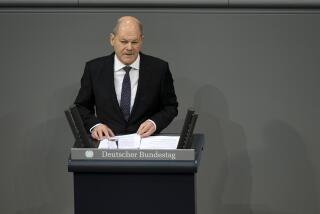Germany’s Reckoning : Hard questions are being raised about whether the Continent’s premier economic power can retain its position in a global economy without sacrificing its high wages and social safety net.
- Share via
OBERPFAFFENHOFEN, Germany — Guenter Pfeiffer has traveled the corporate-restructuring route before, and he knows it’s a bumpy road.
Pfeiffer recalls when four years ago, at the trough of the last German recession, strategic planners at Daimler-Benz, the parent company of the Dornier airplane factory where he works, “came for the first time with their big scythe.” They cut 1,000 of his colleagues from the payroll.
There was pain then but also some hope: Electronics technician Pfeiffer recalls that he and his remaining co-workers were told that if they concentrated on their core product, the Dornier 328 twin-turboprop regional transport, all would be well.
It hasn’t turned out that way. The German economy is faltering again, and the mass layoffs and cutbacks have resumed. Dornier is now trying to cut another 700 jobs from its remaining payroll of 2,500. “Not a very nice way of motivating employees,” Pfeiffer said glumly.
Even more unsettling, some observers say the predicament of Dornier and other German companies signals something much bigger: the demise of this country’s postwar socioeconomic compact, a much-admired agreement that gave workers a significant voice in the running of their plants, ensured generous wages and job security for all, and helped this country avoid much of the labor unrest that plagues nearby Italy and France.
Hard questions are now being raised about whether, in the end, Germany can hold on to its competitive position in a global economy without sacrificing its sterling labor standards and tightly woven social safety net.
“The laws of the world economy are brutal,” said Hans-Peter Froehlich, an economist at the Institute for the German Economy, a conservative think tank in Cologne. “We will have to make changes. Sometimes, when I am putting my children to bed at night, these thoughts come into my mind, and I think that they may not be able to enjoy the same standard of living that I enjoy. We will have to work a lot harder, a lot more flexibly, and maybe for lower wages, to earn our living in today’s environment.”
For many Germans, Froehlich adds, even thinking such thoughts is still taboo.
The current questions about German competitiveness have far-reaching implications. Germany has the most powerful economy in Europe, and when it lags, the whole continent suffers.
Already, 4.1 million work-age people are officially jobless in Germany, more than 10% of the work force. The real number is certainly much higher--perhaps has high as 6 million--because the official jobless rate doesn’t include people in make-work and training programs, or those who have given up looking for jobs altogether.
And only a minority of the official jobless are believed to be the victims of a temporary, cyclical downswing; most appear to have no long-term place in the work force at all. The costs of this situation are daunting, not only in terms of human unhappiness, but also for the government, which must provide unemployment compensation, welfare and make-work programs for these burgeoning millions.
The ballooning cost of these state outlays has been named as one of the culprits behind Germany’s current inability to meet budget-deficit targets for Europe’s planned currency unification--a central goal of the German government. The budget deficit here was 3.6% of domestic output last year, higher than the 3% allowed by the Maastricht Treaty on European Unification.
Bonn recently announced a 50-point reform package aimed at stimulating the economy, creating jobs and bringing the budget deficit into line. But what has yet to be calculated are the long-term social costs of making the German economy attractive enough to lure the new investment needed to create jobs for this country’s unemployed millions.
The root of the problem, say Germany’s managers, is that the costs of German labor and social benefits have simply made this country an unacceptably expensive place to do business. Until these costs are reduced, they say, Germany’s vast, structural unemployment will remain.
“We have a cost crisis that built up slowly and gradually ever since the 1970s,” said Froehlich, whose institute is supported by German business. “It became much more apparent in the past five years as new markets have opened up in Asia and Eastern Europe. All of a sudden, new countries, new continents have appeared on the scene, competing on the basis of much lower labor costs and much higher working hours.”
Consider labor costs in the manufacturing sector in western Germany. Approaching $30 an hour, they are the highest in the world, according to figures prepared by the institute. (Manufacturing labor costs in eastern Germany appear lower at first glance, but when the figures are adjusted for productivity, the former East gets the dubious distinction of world labor-cost champ.)
German managers also blame what they refer to as labor “inflexibility”--the laws, contracts and customs that, in this country, govern everything from how workers may be fired (with six months’ notice) to who can work on Sundays (cake-shop clerks and gas-station attendants; nearly every one else must take the official “pause”).
Thanks to western German union agreements, manufacturing employees work fewer hours a week--36.6, on average--and have more vacation days than their counterparts in any of the 18 industrialized countries in which the institute keeps track.
The amount of time that factory machines may actually run in Germany, by law, is the shortest of any industrialized nation. The Sunday pause is so strict that even gardening is verboten.
And the overall tax burden in western Germany is the highest of any of the countries measured by the institute. Eastern Germany comes in third.
All this must sound extremely inhospitable to an American manager, accustomed as he or she is to such great German no-nos as hiring and firing at will, paying lower wages to the young and inexperienced, and keeping the plant operating on weekends.
And Froehlich says foreign investment statistics for Germany bear out this impression. Though American companies are traditionally well represented here, these days Germany is getting less new foreign investment than all but two of the 11 countries the institute tracks. Much smaller European countries, such as Sweden and the Netherlands, now look more attractive to foreign business planners than mighty Germany.
German managers, ever mindful of this country’s bad historic experience with economic depression and labor unrest, say that although they need to make Germany a competitive place to do business again, they still want a system that gives Joe Lunchpail a fair shake.
“We certainly will not, and don’t want, as an industry, to introduce this hire-and-fire system that you have in America,” said Christian Poppe, senior vice president at Daimler-Benz Aerospace, the Daimler division that includes Dornier. “We are proud of our social network.”
But two blows struck the German economy last year, reducing companies’ willingness to accept their heavy social obligations indefinitely. One was a national manufacturing wage agreement that was well above the inflation rate. The other was the sudden rise of the mark against the U.S. dollar, which suddenly made German products too expensive to export, no matter how lean and mean a manufacturer was.
The Dornier aircraft factory in Oberpfaffenhofen is a showcase of the foreign-exchange cost squeeze, for all international airplane sales are booked in dollars but many of Dornier’s costs are incurred in marks. As the mark rose against the dollar last year, so did Dornier’s costs, while its revenues fell--irrespective of those painful cost-cutting measures that parent company Daimler had implemented in 1992.
Daimler is far from alone in redoubling its quest for competitiveness now. The recent release of uniformly bad government economic data for 1995--particularly in the area of unemployment--has elicited an array of proposals on how to revamp the country’s “social market economy” without wrecking it.
Germany’s unions argue that tens of thousands of jobs could be created if factories would just stop giving their current staffs overtime and instead hired new employees. Union leaders have promised to demand no real wage increase next year, if only industry will pledge to create vast numbers of new jobs in this way.
But managers hoot at this idea: They want to lay workers off, not hire tens of thousands more of them. They are pushing for new flexibility in the workplace--making it easier for individual plants to opt out of national collective bargaining agreements, for instance.
Meanwhile, the German government is offering its own 50-point reform program, which includes sell-offs of state-owned companies, reductions in various state benefits and changes to the tax system.
Also on Bonn’s to-do list are supplements for the microscopic amount of venture capital now available in Germany, incentives for people to open new businesses, pumped-up investment in construction and other pro-business measures.
The government’s package has been widely hailed as a logical and humane approach to Germany’s competitiveness crisis. Although it envisions some reductions in social benefits, officials argue there is room for cutting these without shredding the whole social compact that has kept Germany peaceful for the last 50 years.
For instance, the state-led early retirement and unemployment compensation schemes are notoriously easy to cheat, so the government is proposing to tighten these up. Also up for discussion are reductions in the government provided health-insurance program, which is unbelievably lavish by American standards. For example, a German who feels a bit ill can head off to a spa and charge much of the cost of his treatment to the state.
Norbert Walker, chief economist for Deutsche Bank, Germany’s largest, speaks for many when he says Germans should be willing to part with such “archaic structures,” in the name of restoring the overall health of their national economy.
It remains unclear when and whether the government will be able to push all of its measures through. Some have been floated unsuccessfully before. And with elections scheduled in three states in March, Bonn will certainly be reluctant to do anything too bold until the voters are safely out of the polls.
Also unclear is whether such reforms will be enough, given the scope of Germany’s current problems. Unions, managements and the government are all talking about cutting unemployment in half by 2000. But even if all of Bonn’s proposals go through, nonwage costs to German industry will remain relatively high: Employers will still be paying into federal kitties for health care, pensions and unemployment compensation at the rate of 40% of wages, barely less than the current 41%.
In America, by comparison, employers must pay just 29% of wages into such state benefits funds.
Still, Germany’s current search for solutions holds out the intriguing possibility that an economy doesn’t have to undergo brutal, American-style mass layoffs and dislocations to be successful. Perhaps with the milder mixture of reforms that government, unions and industry are talking about, this country can resume its competitive position without letting its high pay and benefits standards be dragged down by global competition.
Optimists say it can be done.
“I think [Germany’s social safety net] can be financed,” Daimler-Benz’s Poppe said. “You don’t have to be discouraged. It’s just very hard to find the starting point.”
*
(BEGIN TEXT OF INFOBOX / INFOGRAPHIC)
(A comparison of Germany and other industrialized nations) Germany’s vaunted post-World War II socioeconomic covenant, with its generous wages, guaranteed voice for workers and rigid workplace rules, has all but priced its industrial economy out of the world marketplace. Now the country’s corporations are shipping jobs overseas by the tens of thousands to countries--including the United States--where they can make products for far less. A comparison of Germany and other industrialized nations:
Total manufacturing labor costs, dollars per hour (including wages and mandatory non-wage contributions, 1994 figures):
Western Germany: $30.32
Switzerland: 28.60
Belgium: 25.76
Norway: 25.06
Japan: 24.83
Austria: 24.27
Netherlands: 24.05
Denmark: 23.73
Sweden: 21.38
France: 19.94
United States: 19.29
Italy: 18.76
Eastern Germany: 18.29
Canada: 18.22
Ireland: 15.28
Britain: 15.21
Spain: 13.96
Greece: 8.41
Portugal: 6.32
*
Average number of hours worked per week, per worker (manufacturing sector, 1994):
Portugal: 42
Switzerland: 40.5
Japan: 40
Greece: 40
Italy: 40
Luxembourg: 40
Spain: 40
Sweden: 40
United States: 40
France: 39
Ireland: 39
Netherlands: 38.8
Britain: 38.6
Eastern Germany: 38.6
Austria: 38.6
Belgium: 37.8
Norway: 37.5
Denmark: 37
Western Germany: 36.6
Average number of hours worked per year, per worker (manufacturing sector, 1994):
United States: 1,896
Portugal: 1,882
Japan: 1,880
Switzerland: 1,838
Greece: 1,832
Sweden: 1,824
Ireland: 1,794
Luxembourg: 1,784
Spain: 1,772
France: 1,755
Britain: 1,752
Italy: 1,744
Norway: 1,740
Eastern Germany: 1,737
Belgium: 1,729
Austria: 1,722
Netherlands: 1,714
Denmark: 1,687
Western Germany: 1,620
Source: Institute for the German Economy
More to Read
Inside the business of entertainment
The Wide Shot brings you news, analysis and insights on everything from streaming wars to production — and what it all means for the future.
You may occasionally receive promotional content from the Los Angeles Times.








